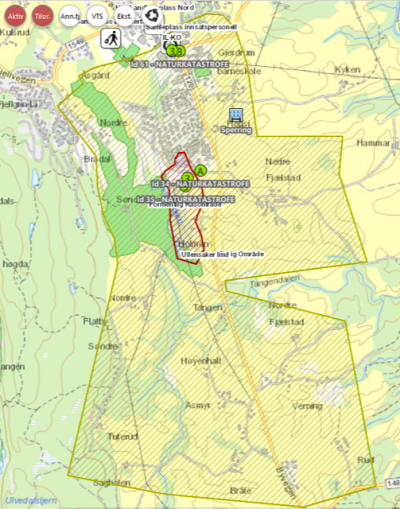UPDATED: Around 1,500 people have had to be evacuated, nearly a dozen were injured and more are missing after a severe landslide devastated a neighbourhood in Gjerdrum, just north of Oslo on Wednesday. Prime Minister Erna Solberg, who arrived on the scene as emergency operations continued, declared it all a “catastrophe,” as a difficult year already plagued by the Corona pandemic drew to a close.

“My thoughts are with all of those who are affected by this, it’s a great catastrophe,” Solberg told reporters outdoors in the rain and snow just after attending meetings with emergency crews from Norway’s search and rescue services, police and military personnel who aided the efforts to find survivors.
A total of 11 residents of the area remained unaccounted for Wednesday evening after the clay-like ground under their homes literally fell out below them. The landslide began around 4am, with the unstable ground continuing to swallow homes through the day that had been left teetering on the edge of the initial slide area. Geologists said it’s difficult to predict such slides involving the ground called kvikkleir, which can be stable for years but then suddenly give way.
Rescue crews had to deal with rain, sleet, snow and the darkness that extends well into the day at this time of the year. Sudden heavy snow this week had already been toppling trees and cutting power to many areas around southeastern Norway, leaving many without electricity and some Internet and mobile phone connections also out of order.
“We believe there are still people in the slide area, but don’t know how many,” Roger Pettersen, operations leader for the police, told state broadcaster NRK Wednesday night. Police “are in dialogue” with relatives of those still missing, some of whom are children.

Emergency crews aided by the military coordinated rescue and evacuation efforts well, with Solberg and her Justice Minister Monica Mæland saying they were “impressed” over how quickly they responded and worked together. Mæland, also on the scene and in charge of government preparedness, said local authorities in Gjerdrum worked well with national authorities and were “getting all the resources they need.”
Helicopters played a critical role in rescuing people stranded on rooftops, pulling them out of thick mud and getting the injured to hospitals in Oslo and nearby Lørenskog. Rescue efforts in the residential area could only be carried out by helicopter because all roads were washed away and the ground was too unstable. Defense personnel were finally able to inspect one empty house “to the degree it was possible,” they told reporters, and found no victims inside. Geologists are also along in the helicopters, to study the slide and mud from above and evaluate the chances of more slides.
Rescue crews also had to evacuate an entire nursing home in the dark after it, as well as the entire neighbourhood, had lost all power. They also had to pay attention to Corona containment efforts and strict infection control procedures, while the most important issue was getting patients and staff to safety.
‘Painful’
Solberg said it was “painful” to see the destruction already caused and to know how many people have lost absolutely everything they owned. Cars parked in driveways disappeared into the mud, and one woman crying on state broadcaster NRK’s ongoing coverage throughout the day related how she and her family had just moved into their home and refurbished it. “This is where we were going to live,” she said between sobs. One man looking after his three grandchildren while their mother worked a hospital night shift described being awakened by loud noises and then a neighbour pounding on the door. “We just had to grab whatever clothes we could find and get out of the house,” he calmly told NRK. Photos taken later by helicopter crews showed his daughter’s home on the edge of the abyss, still standing, but with its garage torn away.
Everyone involved was holding out hope that the 15 residents still unaccounted for by 5:30pm were not at home during the holidays and perhaps were, like thousands of other Norwegians on Wednesday, staying in cabins or areas where there was no electricity, no radio or TV coverage and no Internet for hours on Wednesday morning. Police officials noted that they may simply be out of contact.
The chilling alternative was that they could be buried under the mud. At least 14 addresses in the area were directly affected by the landslide that created a catastrophe area measuring roughly 700 by 300 meters.
“It’s serious when we describe this as a catastrophe,” operations leader Pettersen of the police told NRK: “It’s a large slide area with many homes.” He stressed that “we are still looking for survivors, not casualties.” All those evacuated, amounting to fully 30 percent of Ask’s total population, were initially taken to the local Gjerdrum Ungdomsskole (junior high school) and later to area hotels at Skedsmo and Gardermoen.
NewsInEnglish.no/Nina Berglund

